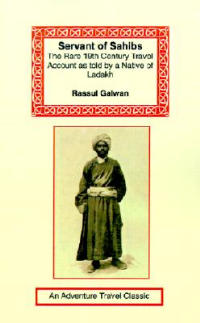 Servant of Sahibs
Servant of Sahibs

Abbiamo conosciuto la "via della seta" attraverso gli occhi dell'occidente con i libri dei viaggiatori inglesi, ma anche tanti italiani, del secolo scorso, ma questi personaggi erano accompagnati da guide, cuochi, cavallanti, coolie, che rimangono sempre sullo sfondo di un immenso e deserto palcoscenico. Rassul Galwan è uno di questi personaggi: un ragazzino cencioso il povero che vive nei sobborghi di lei e lotta duramente nella vita fino al divenire la prova della legge cioè il capo di tutti gli spedizionieri. “Servants of Sahibs” è l'autobiografia di Rassul che, in un inglese elementare, narra le peripezie al servizio degli inglesi.
Fra i suoi clienti incontriamo Sir Francis Younghusband, eclettico militare che dopo aver trucidato migliaia di tibetani nell'invasione del 1904, si innamora del "paese delle nevi". È proprio Younghusband a scrivere l'introduzione nel 1923 mentre quello che oggi chiameremo editing è curato dai coniugi Littledale. Per quanto rudimentale l'inglese di Galwan ci permette di comprendere la durissima vita di chi accompagnò ricchi ed avventurosi esploratori nella Trans Himalaya e nel Tibet. Molto è cambiato nella quotidianità dei trekking in Ladakh.dove, fortunatamente, non vi sono portatori come in Nepal, ma le salmerie sono trasportate da cavalli. La ristampa è ovviamente quella dell'originale inglese del 1923 e racchiude anche la riproduzione di una pagina del manoscritto originale.
|
|
There has never been another book remotely similar to “Servant of Sahibs”!
It is the remarkable, but true, story of Rassul Galwan, a native of Ladakh who early on in life became a trusted assistant to various nineteenth century European explorers. Setting off at a young age, Galwan was soon to be found in the company of adventure travelers like Sir Francis Younghusband, who explored the Tibetan plateau, the Pamir mountains and the deserts of Central Asia.
Quietly bringing up the rear of these now-famous caravans was Rassul Galwan. Having taught himself how to run the expedition, the intelligent mountaineer was soon turning his talents to acquiring languages, picking up a working knowledge of Chinese and English, among others.
It was with this rudimentary English vocabulary that Rassul Galwan authored “Servants of Sahibs”, the only account of its kind. “Everywhere he like, there he go. From top hills to hills tops,” Galwan wrote about his life of journeying. The resulting delightful book is a first-hand account of the most famous Central Asian expeditions, as seen by Galwan, and the natives involved. The story remains as entertaining as the day it was written, its pages filled with excitement, adventure and laughter.
Ghulam Rassul Galwan was born in the mid-nineteenth century in the small mountain village of Leh. The Ladakhi family was a poor one, and as a child Ghulam helped his mother winnow wheat, watched the goats while they grazed, or collected animal dung for fuel. Yet Ghulam was an ambitious and clever child whose determination to read and write was met with derision by his mother, who sent him to work for a tailor instead. That was not a success, so the enterprising young man eventually found work with the British sahibs.
His career as one of the most famous porters of the era saw him working with a number of key expeditions in Central Asia, including accompanying Younghusband through Chinese Turkestan, journeying with Lord Dunmore through the Pamir mountains and travelling with the Littledales across Tibet. In a literature dominated by the European perspective, Ghulam’s autobiographical account provides a rare insight into a forgotten world of intrepid voyagers whose native names are now largely lost to history. |